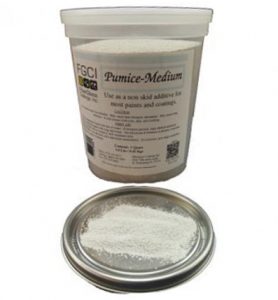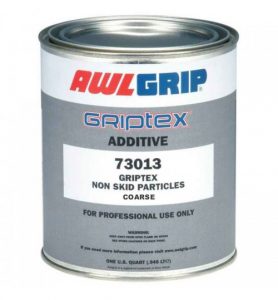Why Non-Skid Deck Paint is Essential
Safety on boats is crucial, particularly on decks where water can create a slipping hazard. Whether for recreational purposes or professional boating, non-skid surfaces are essential to prevent accidents and ensure stability. Non-skid deck paint offers a practical solution that enhances traction and improves the overall appearance of the boat, making it a popular choice among boat owners.
Types of Non-Skid Deck Paint
One option is textured paint, which incorporates non-slip additives like silica, polymer beads, or rubber to create a rough surface that improves grip. Textured paints are commonly used in areas exposed to water, providing excellent traction. Another type is pre-mixed non-skid paint, which is convenient and easy to use, making it ideal for DIY enthusiasts. These paints come ready to apply with the non-slip additives already mixed in, ensuring consistency in texture. Some prefer additive-based non-skid solutions, which allow users to mix non-skid additives such as sand, silica, or specialized granules into regular marine paint. This offers the flexibility to customize the texture and non-slip performance based on individual needs.

Non-Skid is a pumice additive that can be added to most paints and gel coats to provide a slip resistant surface. Learn more.
Key Factors to Consider When Choosing Non-Skid Deck Paint
Durability is one of the primary considerations when selecting non-skid paint. The paint should be able to withstand marine conditions such as saltwater exposure, UV rays, and heavy foot traffic. Choosing a durable paint ensures that the non-skid properties remain intact over time. Ease of application is another important factor, particularly for those who plan to apply the paint themselves. Pre-mixed options simplify the process, while additive-based solutions offer more customization but require additional effort to prepare. Aesthetic preferences should also be taken into account.
Non-skid deck paints come in a variety of colors and finishes, giving boaters the ability to match their deck to the overall look of the vessel, whether they prefer a sleek, modern design or something more traditional. Additionally, it is essential to ensure the paint provides waterproofing to prevent water damage and includes UV protection to maintain the paint’s integrity under prolonged sun exposure. Both of these features contribute to the longevity of the paint.

Griptex is a polymer bead aggregate used to provide non skid deck and step areas when mixed with an Awlgrip topcoat. Learn more.
Step-by-Step Guide to Applying Non-Skid Deck Paint
The first step is preparation. Start by thoroughly cleaning the deck to remove any dirt, grease, or old paint that could interfere with the adhesion of the new paint. Once clean, sand the surface to create an even texture that allows the paint to bond properly. After sanding, wipe down the deck with a solvent to remove any remaining dust or debris, ensuring a clean and smooth surface.

Priming the deck is the next step, and depending on the paint you select, a marine-grade primer may be necessary. This primer helps the paint adhere to the surface more effectively and improves durability. When it comes to painting, apply the non-skid paint with a brush or roller, ensuring even coverage across the deck. It’s important to apply multiple thin layers rather than one thick coat, as this improves the durability and performance of the non-skid properties. Allow for sufficient drying time between each coat. Once the final layer is applied, give the paint ample time to cure before exposing the deck to foot traffic or water, as rushing this step can reduce the effectiveness and lifespan of the paint.
Maintenance Tips for Non-Skid Boat Deck Paint
To maintain the effectiveness of the non-skid surface, it’s important to clean the deck regularly using mild soap and water. Dirt and debris can accumulate over time, reducing traction and making the surface less safe. It’s also best to avoid using abrasive cleaners, as they can wear down the non-skid texture, diminishing its performance. Instead, opt for gentle cleaning methods that preserve the surface. In high-traffic areas, the paint may wear down over time. Periodic touch-ups or repainting may be necessary to maintain the non-skid properties, especially in areas that experience heavy use.
Top Non-Skid Deck Paint Brands
There are several reputable brands known for producing high-quality non-skid deck paints that combine durability, ease of use, and long-lasting performance. Interlux is recognized for its exceptional durability and UV resistance, making it an excellent choice for long-term use. TotalBoat offers a range of easy-to-apply paints that provide excellent traction and are favored by DIY boat owners. KiwiGrip is popular for its environmentally friendly formulation and customizable texture, allowing boaters to adjust the level of non-skid based on their needs. Rust-Oleum is a budget-friendly option known for its durability and resistance to water, making it a practical choice for those seeking a cost-effective solution.
Enhance Safety and Aesthetics with Non-Skid Paint
As you can see choosing the right non-skid deck paint is essential for ensuring both safety and aesthetics on your boat. By selecting a paint or additive that balances durability, ease of application, and visual appeal, you can enjoy a safer, more attractive deck that stands up to marine conditions. Investing in non-skid paint enhances your boating experience, providing peace of mind while also improving the overall appearance of your vessel. If you need any assistance selecting non skid boat paint feel free to contact the customer support team at Bottom Paint Store.

